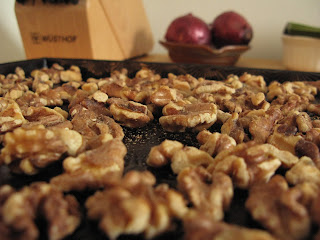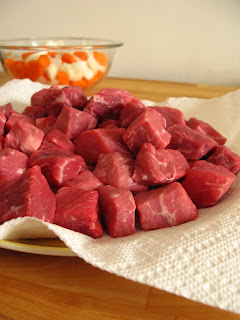The true test of how good a dish really is, in my mind, is how well it's universally liked. If you're inclined to agree with me on this one, then I can guarantee that you will love this recipe for an earthy and savory green lentil patê.
Often when A and I escape from the big city, we find ourselves in Bucks County, PA visiting friends and family. One place I'm always eager to go to is Aunt J and Uncle G's house in the woods. This spot is also known as The Vortex for its time proven ability to suck visitors in for endless hours of music, imbibing, and brain-meltingly good food. Aunt J always puts on a fabulous spread, whether it be her 6 course Midsummer Night's Feast from this past year or her annual New Year's Day brunch. On more than one occasion, she's made this patê and even when it sits side by side other tasties like caviar, cheeses, and patê-of-the-meat-variety it's always been one of the first items that people devour. Vegan patê so good that it gives all other hors d'oeuvres heavyweights a run for their money.

A couple weeks ago, A and I were the hosts for a gathering of the Astoria Whisky Society. I thought it quite apropos to make a batch of this patê to fill our stomachs in preparation for Whisky Smashes. And once again, it did not fail to disappoint. Believe me: it's just that good.
***Note: A couple of ingredients on this list *might* be hard to find if you don't have access to a good whole/organic foods grocery. Aunt J was good enough to provide me her ingredient substitutions, but luckily my local organics shop had everything I needed. So don't sweat it if umeboshi paste is nowhere in sight.
Umeboshi paste is a common component in Japanese food. It is a paste made out of umeboshi plums. Despite its fruit base, it is not sweet at all but has a strong sour and salty profile. As per Aunt J's recommendation, if you can't find umeboshi you can instead substitute about a tablespoon worth of finely minced cornichons with a dash of vinegar (rice wine or ume vinegar), enough to make a paste.
 I was able to find barley miso, but any other variety (red or white miso) will be fine.
I was able to find barley miso, but any other variety (red or white miso) will be fine. Mirin is a sweet rice wine similar to Sake, often used in Japansese cooking. My pantry was out of mirin, but since I made this on a Saturday morning, A and I had an open bottle of champagne. A tablespoon of champagne for mirin was a perfectly acceptable substitute, as would be white wine in a pinch.
Vegan Green Lentil Patê
2/3 cup dried green lentils
1 large bay leaf
2 cups walnuts, whole and unsalted
1 Tbs extra virgin olive oil
3 cups diced onion
1 Tbs minced garlic
1 Tbs mirin
1 Tbs plus 1tsp umeboshi paste
1.5 Tbs barley miso
Pre-heat your oven to 350 degrees.
While the oven is heating, cook your lentils (with the bay leaf) in enough water to cover them by 2 inches. Bring the water to a boil, then lower to a simmer, cover, and cook for about 30-40 minutes.
While your lentils are cooking, spread your walnuts out in a single layer on a baking sheet and roast them for about 6-8 minutes. The goal is to get them toasty and maybe about 1 shade darker than they were before.
In a fine-meshed sieve, drain your cooked lentils.
In a large sauté pan, heat the olive oil over medium-high heat. Sauté the onions for about 10 minutes. Add the garlic and cook for about 5 minutes more.
Once the onion and garlic has cooled off a little bit, combine the lentils, walnuts, onion, garlic, mirin, umeboshi, and miso in a food processor. Alternately, you can put everything in a large bowl and process with a stick blender. Blend until you have a fine and uniform paste. You almost certainly won't need any salt. The umeboshi and barley miso are quite salty on their own. But, just in case, taste for seasoning at this stage.

Before serving the patê, I wanted to put it in a sort of molded shape. I took a medium-sized Pyrex ramekin and lightly greased it with olive oil before scooping the patê into it and smoothing out the top. I covered it with a bit of saran wrap and cooled it in the fridge for about a couple hours. When I was ready to serve, I took out the ramekin and inverted it over a plate. The patê came out very easily and made for a nice presentation.
Left-over patê (if you end up with such a thing) could be used in all sorts of delicious applications: spooned into lettuce cups and garnished with scallions or chives, slathered on slices of bread as part of a sandwich. Endless possibilities.
This recipe made about 2 to 2.5 cups worth of patê. Covered and in the fridge, it will keep for 3-5 days.









